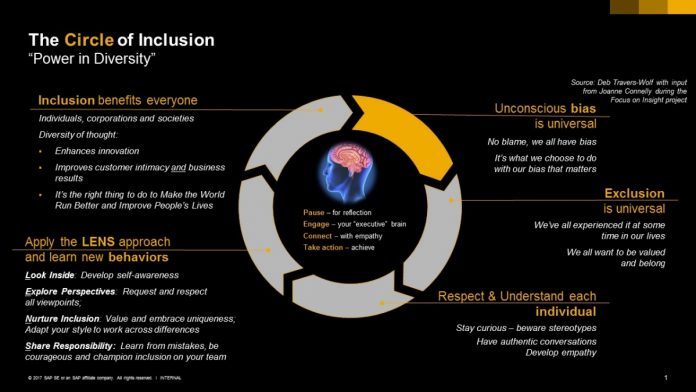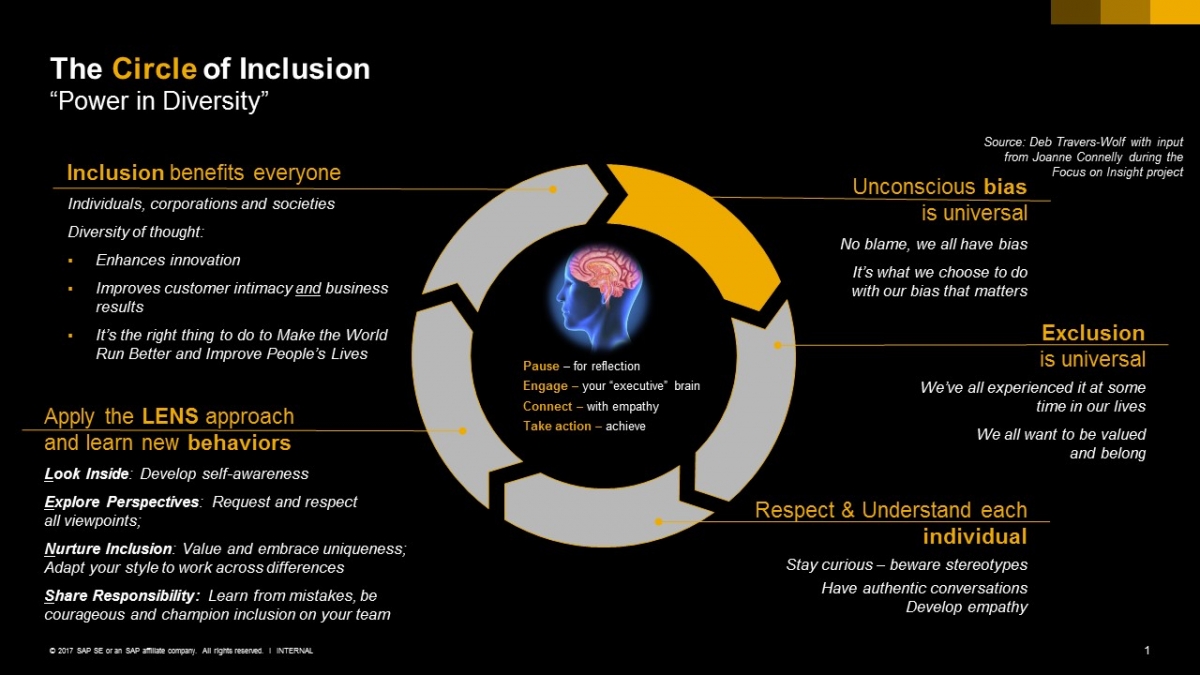
“Can’t you just give me a check list to for diversity and inclusion’?”
If you’re like me and have been asked this question before and tried to create that checklist, you’ll realize just how challenging that endeavour is—the possibilities are endless! And it needs to be personalized to each individual.
While diversity is about the actions you take, inclusion is about the mindsets and behaviors you demonstrate, each and every day, one customer, one colleague, and one team member at a time. It’s about achieving the power of “Collective Intelligence.”
Why don’t you just tell me what I need to know and do?
- Your journey will be different than mine, because of your own unique combination of mindsets, experiences, and behaviors.
- But the good news is, no matter where we are in the world, we’re all just people, too. People wanting to be valued and to belong, and feel safe enough to contribute what we really believe will make a difference.
Like trust, inclusion can be a virtuous or a vicious circle. The key to creating your own “Circle of Inclusion” is a desire to become a more inclusive partner with your customers, colleagues, or team members. You can create your own virtuous circle, one conversation at a time and one human being at a time, by starting in the center of the circle, and recognizing each of the key mindsets and skillsets required to create a virtuous Circle of Inclusion. (Download the graphic at the end of this article.)

If you can’t tell me what to do, then how am I going to actually do it?
While I can’t give you the specific answers that are exactly right for you, I can help you find those answers for yourself, by asking you some questions. It’s a key principle of our coaching practice here at SAP.
The following 10 questions will help you build on your own existing mindsets and behaviors, and zero in on your own unique answers, setting you on the path to creating your own personal “Circle of Inclusion” and becoming a more inclusive trusted advisor, colleague, or leader.
Question 1: What is the benefit of authentically including your customers and colleagues in conversations and decisions?
- What’s the benefit, dividend, payback if I do this one customer and one conversation at a time?
- What’s the price if I don’t?
Question 2: Are you ready to explore how to become more “human with your customers” or “inclusive with your colleagues and team members”?
- What am I missing out on if I don’t?
Question 3: Are you currently a “clumsy colleague” or an “artful advocate” for inclusion?
- If you were to place yourself on a continuum with clumsy colleague at one end, and artful advocate at the other, where would you place yourself?
Question 4: How “cognitively compromised” are you right now?
- Are you in “c-state”? (calm, clear, collected, composed, clever, and considered in your thinking)?
- Or are you in “F-state” (fast, frantic, flustered, furious, fearful)?
- Have you ever tried to change a habit when you’re in “F-state”? If so, you’ll know just how difficult that can be.
Question 5: In this situation, what is your biggest bias?
- How is it influencing your actions and behavior toward this customer, colleague, or team member?
Question 6: How did it feel the last time you were excluded from a decision or a conversation?
- What was the impact or consequence on the outcome of the decision or conversation (i.e., what was not considered as a result of your absense?)?
Question 7: What do you value most?
- Who may you not be fully respecting or understanding in this conversation or in your team?
- What insight or information are you missing out on as a result? What is the impact or risk of that?
Question 8: How can you value/appreciate them more?
- How can you make them feel safer, so they contribute even more insight and generate more creativity and new ideas?
Question 9: How can you more effectively connect and engage with them?
- What might you need to do to adapt or flex, and understand their perspective?
Question 10: What will you do today, to take one step to becoming a more artful advocate in your next customer, colleague, or team meeting?
So that’s it?
Each and every time you endeavour to reinforce your Circle of Inclusion, you will learn something new (if you are open and ready to explore). You can start creating your own “Circle of Inclusion” today by asking yourself some important questions. If you’re not sure of some of your answers, you can ask others on your team as their insights may provide you with some additional ideas to find the “Power in Diversity,” i.e., inclusion.
Your success in creating your own virtuous Circle of Inclusion likely will depend on a variety of influences:
- Your motivation, likely the result of the value you place on becoming more inclusive and the benefits you hope to realize and whether you have a “fixed or a growth mindset.”
- Your skill, almost certainly dependent upon the “state” of your brain, what you say to yourself in your own mind, and the behaviors you’ve learned throughout your life.
- A powerful past exclusion experience probably will increase your humility and your humanity, as well as your desire to provide an inclusive environment for all; customers, colleagues, and team members alike.
- Your ability to stay curious and connect with empathy—one person at a time—will help you respect and understand each individual, as an individual.
- Your discipline in applying a new set of LENSes will help you learn both new mindsets and new behaviors. At SAP, we recommend you:
- Look Inside
- Explore Perspectives
- Nurture Inclusion
- Share Responsibility—be a courageous champion
Diversity without inclusion is just diversity. Inclusion is the dividend you reap when you create diversity and approach it with the right mindset and skillset.
You can start creating your own Circle of Inclusion by changing your own conversations with others. Stay curious, connect with empathy, and delight in creating the “Music of Strangers.” It comes when you “Focus on Insight & Inclusion.” #businessbeyondbias is what we stand for at SAP.
Deborah Travers-Wolf is a Learning and Development Consultant at SAP and a subject matter expert in the design of SAP’s Focus on Insight program.




